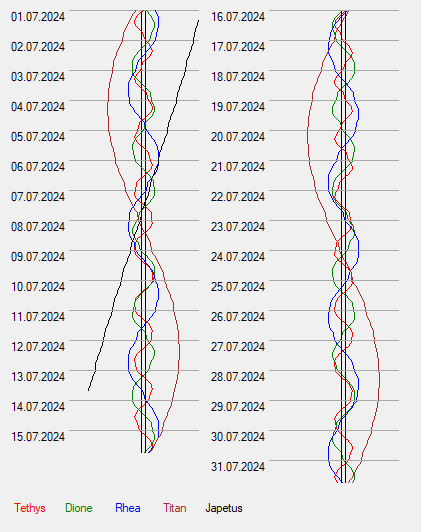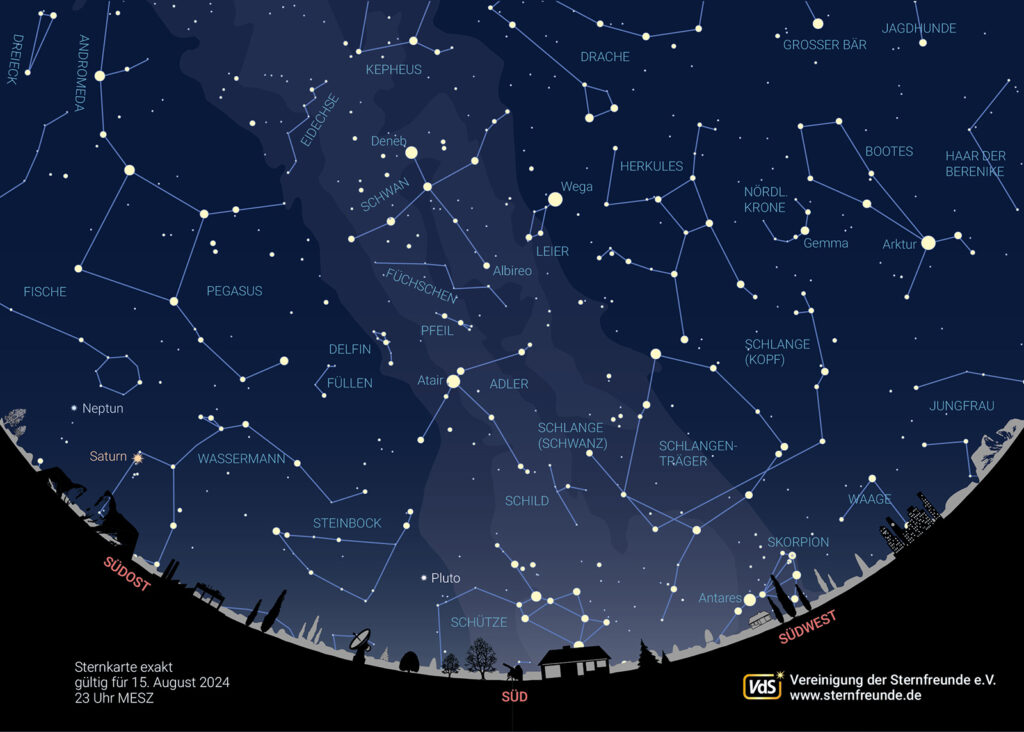The starry sky in July 2024
SUN AND MOON
On the 20th of the previous month, the sun reached its highest point in the sky at noon and is now sinking again. The length of the day in Zweibrücken decreases from 16 hours 17 minutes to 15 hours 17 minutes over the course of the month. From July 5, we again reach the point at which it becomes dark enough for astronomical observations. Even if only at 1:20 a.m. for a whole 15 minutes. During these few minutes, the sun already reaches a position of more than 18 degrees below the horizon, which is considered night for amateur astronomers. Also on the morning of July 5 at 5:00 a.m., the earth is at its furthest point from the sun. The distance at this time is 152,100,000 kilometers.
On the 21st of the month, the full moon makes it difficult to observe fainter objects. In the night from July 24 to 25, our Earth companion apparently visits the planet Saturn. At 1:00 a.m., the angular distance is just under 2 degrees, i.e. almost four full moon diameters.

PLANETS
The first planets reappear in the night sky.
Mercury reaches its almost maximum possible eastern angular distance from the sun on July 22 at just under 27 degrees. The large angular distance is due to the fact that five days later it is at its furthest point from the sun at a distance of almost 70 million kilometers. Unfortunately, this is not sufficient for evening visibility as it is too far south of the Sun's apparent orbit around the Earth (ecliptic).
Venus was at an upper conjunction to the Sun on 04.06.2023. The angle to the sun of almost 15 degrees is not yet sufficient for evening visibility. In August, it is possible to find it low in the evening sky.
Mars increases its morning visibility considerably and reaches the northern parts of the zodiac. On the first of the month, it crosses the horizon line in Zweibrücken at 2:23 a.m. and continues to rise early to 1:21 a.m. at the end of the month.
Jupiter can be observed in the morning sky. It rises at 1:47 a.m. on the last day of the month. However, it does not reach its peak with the opposition until the beginning of December.
The Saturn becomes the planet of the whole night. It rises at 23:39 in the middle of the month. Attentive observers will have noticed that they are increasingly looking at the edge of the ring. The observation angle is only 2 degrees in July. Although it will increase again slightly over the course of the year, it will only decrease to 0 degrees by the end of March 2025. At that time, we will be looking at the edge of the ring, which will then appear invisible to us. The planet named after the Roman god of wealth and harvest reaches its opposition position at the beginning of September. On the right is the position of Saturn's moons for July. (Click to enlarge.)
From the middle of the month, the planet Uranus the object of observation in the second half of the night.
Neptune begins its opposition loop, but still poses a challenge in the morning sky. A telescope is required to observe both planets, Uranus and Neptune, as they can never be seen with the naked eye.
Formerly the ninth planet and now belonging to the minor planets Pluto is at opposition to the sun on July 23. However, it can only be observed in larger telescopes, such as those at observatories.
STARRY SKY
Deep in the East the winged horse of antiquity, Pegasus, stretches its head above the layers of haze near the horizon.
Just above the Southern horizon Scorpio and Sagittarius are still in the sky. They are only significantly higher in the night sky in the Mediterranean regions.
A little further to West the inconspicuous constellation of the Northern Crown and Bootes can still be observed. As already here experts expect a nova to appear by September 2024.
The summer triangle with Vega, Atair and Deneb is approaching from the east. Zenith.
High above us Hercules and the inconspicuous dragon still stand.
The big bear is already sinking on northern night sky towards the west. Opposite Polaris, as seen from the Great Bear, the "celestial W", Cassiopeia, slowly rises into the northern regions.
The following sky view is valid for July 1 at 0 am, July 15 at 11 pm and July 30 at 10 pm.


